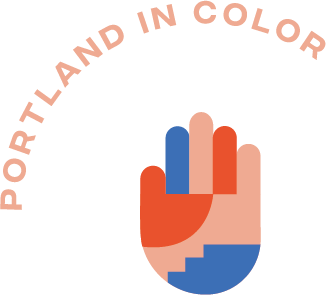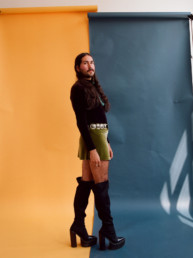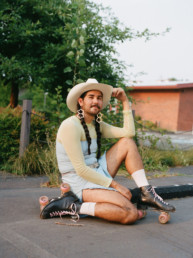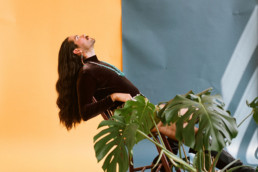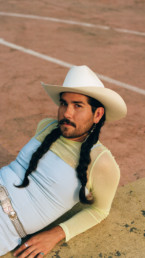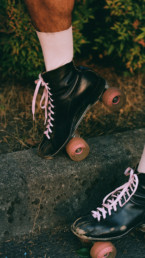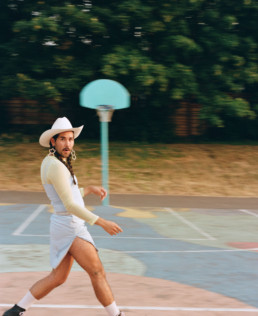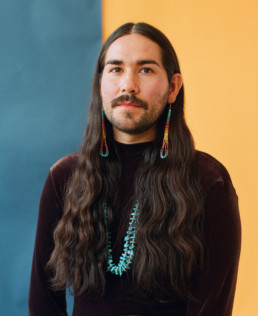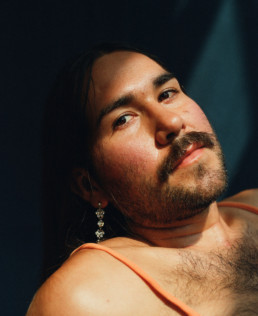EVAN BENALLY ATWOOD
You can’t care about the environment if you’re never out in it.
Name: Evan Benally Atwood
Pronouns: They/Them
Background: A queer Diné creative from the desert
Medium of choice: Photogragraphy, film, ink on paper, acrylic washes
Karaoke jam: Hands Down – Dashboard Confessional
Local artists you’re excited about: Daniel Shinseki (AMAJA), Illegal Son, Haley Heynderickx, SÁVILA
WEBSITE
www.evanjamesatwood.com
INSTAGRAM
@evanbenallyatwood
VENMO
@evanjamesatwood
Evan Benally Atwood glides toward me, roller skating, on a sweltering August morning. We are meeting in the Columbia Gorge and a haze of orange chokes the sky above us. We both lament the constant wildfire smoke during our summers now. The sun hovers low on the horizon as we embrace, like it is unsure if it wants to spend the day fighting through all the particulate matter.
Evan and I met virtually earlier this year in the Spring — I interviewed them for Aperture, a photography magazine and publisher based in New York City, about their work as a photographer and filmmaker. We spoke about decolonizing gender and image-making. In that interview they told me about how they identify as nádleehí, a Diné (Navajo) word that roughly translates to one who constantly transforms. “I never claimed the term two-spirit—it wasn’t something I felt inside. For me, nádleehí is that which is always becoming.” Reflecting on this, Evan told me that they feel more masculine and more feminine today than they did a few years ago.
We hang out at the skate park for a while. Evan zooms around and laughs, telling me they don’t have any brakes. After an hour, we sit down to talk.
“When I am comfortable with my queer self and my Indigenous self, when I have love for the body that I am in, anything that I make embodies an overlap between an Indigenous identity and a queer one.”
How does your background influence the work you make?
It influences everything I create. When I am comfortable with my queer self and my Indigenous self, when I have love for the body that I am in, anything that I make embodies an overlap between an Indigenous identity and a queer one. I feel like I have harmony in my body between the two, but the queer community doesn’t always see Indigenous perspectives. Some Indigenous people don’t hold their queer relatives close.
I’ve been working on this project about Indigenous queer joy which feels way too perfect. It’s a collaboration with the Northwest Portland Area Indian Health Board. Nate Lemuel (@darklistedphotography) and I worked on this project in Albuquerque, Tulsa, Minneapolis, Seattle, and Portland. I think it’s so important. With the state of the world, the goal of the project was to connect with these people and celebrate them. We traveled over 2,000 miles to connect with queer Indigenous people in all of these places. It wasn’t only documenting queer Indigenous joy, though. We were creating it! We took up space in nature. We celebrated each other! That was my only goal. By taking up space we created space for ourselves.
I saw queers on this project who were so young and so comfortable with themselves. They don’t give a fuck what anyone else thinks, which is beautiful. I used to care so much about what other people thought of me.
How did you end up in Portland?
My best friend Kerry moved here after college, which is where we met. She’s in so many of my photos. She’s like a sister, wife, and best friend. Now she’s moving to LA and I support her, but there’s no way I’m going back to LA! We graduated with our business degrees from Northern Arizona University in 2015 and she came up right after. I was in LA after school and then I moved to Portland in 2016.
What’s keeping you here?
I keep getting work here. I also love being outside — backpacking, hiking, swimming. I was recently asked about my creative space and, for me, it isn’t a studio or something like that. My creative space is outside. Connecting with nature is one of the most important things that people need to do. People aren’t doing it. You can’t care about the environment if you’re never out in it. Then again, there’s lots of really conservative people in beautiful places.
What do you think about the outdoor culture of the Pacific Northwest? And what do you think about how it is represented in advertising and media?
In reality, it’s white dominated. That’s obvious. You can’t go on a trail without passing endless white people. That makes it important to me to be on those trails. To be outdoors.
A critique of the marketing of the outdoors would be that everyone wants to show that they are diverse. In reality, if all you’re doing is putting beautiful Black and brown people as your talent and not as your creatives, then you are being performative.
I recently got into Black Belt Eagle Scout. I love your music videos with them. What does it feel like to create with other native people?
Effortless. I don’t even have the words. Great isn’t good enough. It’s vital to work with other queer Indigenous people. I have been working on this project called Waveguides. It’s a documentary following six Indigenous women musicians made by a majority Indigenous crew. Everyone has their roots and honors where they are coming from. We are telling these stories that aren’t rooted in trauma. Most non-native storytellers start from trauma when they tell native stories. We do it to ourselves too. “How do I milk my trauma?” That’s why I focus on joy and telling real stories. It’s so simple. It’s Indigenous people working as a team to tell the story of other Indigenous people. It’s visual sovereignty. There’s a lot to unpack, but we are not here to focus on the trauma, we are here to exist.
Working with KP [of Black Belt Eagle Scout] is amazing. When we took photos for the [forthcoming] Indigiqueer Joy project it was so easy. It was her birthday so I came with presents. I was like, I’m here to celebrate you! We went out to Kukutali on the Swinomish Reservation. It was so effortless to be happy. It feels really good.
I love the quote on your website from Ruth H. Hopkins: “Sacred sites are Indigenous places of worship, our outdoor cathedrals. In the modern era, they have been consistently targeted for destruction by racist demagogues, extractive industries, and those who are otherwise estranged from their spiritual selves and see only dollar signs.” How do you see that happening around here?
The first thing that comes to mind is using the name Mount Hood instead of Wy’East. The British dude that they named it after never even saw the mountain. Same with Rainier and Tahoma. It feels important to know where you are and talk about it. But it can’t be just a land acknowledgement.
Portland wants to say they care, but then they offer you a low rate. [People] want to do a land acknowledgment, but they don’t want to pay you. They want to feel good about themselves. They don’t want to feel uncomfortable. We need accountability.
People demanding water for their cows are exploiting the land. They leave nothing for their children or their children’s children. They leave nothing for the ecosystem. We’re all a part of it, though. I only know how to appreciate that land, how to see its beauty, and make every decision from that connection.
And to go back to Ruth H. Hopkins, it is not just avoiding the exploitation of the land, it’s viewing the land as a sacred site. I think of how Multnomah Falls has become so overcrowded you now have to get permits. It’s a pit stop. It’s not a place to worship.
I’ve always loved camping and being outside. I want to throw my phone in the river. A lot of people don’t want to be outside, to be dirty and sweaty all day. It’s not always easy, but I love it so much.
Too many Black and brown people don’t feel comfortable outside, for good reason. I don’t have a solution for that. Non-Black Portlanders need to recognize how much privilege they carry to be able to be in nature. I would say [we need to] make more space for Black and brown people in the outdoors.
I asked people on the Indigiqueer Joy project where they felt the most access to joy. Almost everyone said next to the water. So, Black and brown people go outdoors, take up space. You deserve it.
How can Portland support your community?
I would say give people their first jobs. Take chances. Don’t expect perfect grammar, or any kind of perfection. I want intergenerational work. I want old Black and brown queers to be able to find work. I want a union in the film industry for the people of color here.
This work was made possible in part to a Make | Learn | Build Grant from the Regional Arts and Cultural Council.
